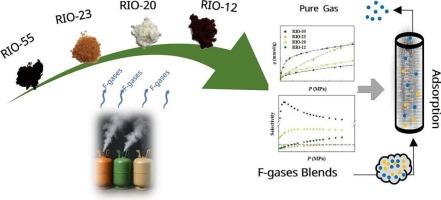Porous organic polymers for the adsorption of fluorinated gases
IF 5.2
2区 化学
Q2 CHEMISTRY, PHYSICAL
引用次数: 0
Abstract
The development of advanced materials exhibiting self-assembling and selective adsorption properties for the capture of fluorinated gases (F-gases) has attracted substantial attention, driven by the urgent need to mitigate the impacts of climate change. For the use of these materials at an industrial scale, the preparation of these materials must be both effective and economically accessible. Porous Organic Polymers (POPs) represent a broad and versatile class of materials entirely constructed from organic building blocks linked through covalent bonds. Their intrinsic porosity, high surface area, and tuneable functionality, including both crystalline and amorphous structures, make them attractive for a wide range of applications. Some of these properties can facilitate strong and selective interactions with F-gas molecules. These advanced materials offer promising alternatives to support the circular economy initiatives in the refrigeration sector, as encouraged by the European Union. In this study, the adsorption equilibria of difluoromethane (R-32), pentafluoroethane (R-125), 1,1,1-tetrafluoroethane (R-134a), sulphur hexafluoride (SF6), and nitrogen (N2) were experimentally determined on four distinct POPs: RIO-55, RIO-23, RIO-20, and RIO-12. The experimental data were fitted using the Dual-Site Langmuir adsorption model to capture the diversity of adsorption behaviours observed in these systems. Furthermore, competitive selectivity for representative commercial blends, R-410 A, R-407C, and SF6/N2, was evaluated through Ideal Adsorbed Solution Theory (IAST) calculations. Among the materials investigated, RIO-55 demonstrated the highest selectivity, particularly under low-pressure conditions, due to its optimal balance between microporosity and mesoporosity. This intrinsic ionic character further enhances interactions, making it the most promising candidate for the selective capture of F-gases.

用于吸附氟化气体的多孔有机聚合物
由于迫切需要减轻气候变化的影响,开发具有自组装和选择性吸附特性的先进材料以捕获氟化气体(f-气体)引起了极大的关注。为了在工业规模上使用这些材料,这些材料的制备必须既有效又经济。多孔有机聚合物(POPs)是一种广泛而通用的材料,完全由有机构建块通过共价键连接而成。它们固有的孔隙率,高表面积和可调谐的功能,包括晶体和非晶结构,使它们具有广泛的应用吸引力。其中一些性质可以促进与f -气体分子的强和选择性相互作用。这些先进材料为支持欧盟鼓励的制冷行业循环经济倡议提供了有希望的替代方案。在本研究中,实验测定了四种不同POPs (RIO-55、RIO-23、RIO-20和RIO-12)对二氟甲烷(R-32)、五氟乙烷(R-125)、1,1,1-四氟乙烷(R-134a)、六氟化硫(SF6)和氮(N2)的吸附平衡。实验数据采用双点Langmuir吸附模型拟合,以捕捉在这些体系中观察到的吸附行为的多样性。此外,通过理想吸附溶液理论(IAST)计算,对代表性的商业共混物R-410 A、R-407C和SF6/N2的竞争选择性进行了评估。在所研究的材料中,RIO-55表现出最高的选择性,特别是在低压条件下,由于其在微孔和介孔之间的最佳平衡。这种固有的离子特性进一步增强了相互作用,使其成为选择性捕获f气体最有希望的候选者。
本文章由计算机程序翻译,如有差异,请以英文原文为准。
求助全文
约1分钟内获得全文
求助全文
来源期刊

Journal of Molecular Liquids
化学-物理:原子、分子和化学物理
CiteScore
10.30
自引率
16.70%
发文量
2597
审稿时长
78 days
期刊介绍:
The journal includes papers in the following areas:
– Simple organic liquids and mixtures
– Ionic liquids
– Surfactant solutions (including micelles and vesicles) and liquid interfaces
– Colloidal solutions and nanoparticles
– Thermotropic and lyotropic liquid crystals
– Ferrofluids
– Water, aqueous solutions and other hydrogen-bonded liquids
– Lubricants, polymer solutions and melts
– Molten metals and salts
– Phase transitions and critical phenomena in liquids and confined fluids
– Self assembly in complex liquids.– Biomolecules in solution
The emphasis is on the molecular (or microscopic) understanding of particular liquids or liquid systems, especially concerning structure, dynamics and intermolecular forces. The experimental techniques used may include:
– Conventional spectroscopy (mid-IR and far-IR, Raman, NMR, etc.)
– Non-linear optics and time resolved spectroscopy (psec, fsec, asec, ISRS, etc.)
– Light scattering (Rayleigh, Brillouin, PCS, etc.)
– Dielectric relaxation
– X-ray and neutron scattering and diffraction.
Experimental studies, computer simulations (MD or MC) and analytical theory will be considered for publication; papers just reporting experimental results that do not contribute to the understanding of the fundamentals of molecular and ionic liquids will not be accepted. Only papers of a non-routine nature and advancing the field will be considered for publication.
 求助内容:
求助内容: 应助结果提醒方式:
应助结果提醒方式:


